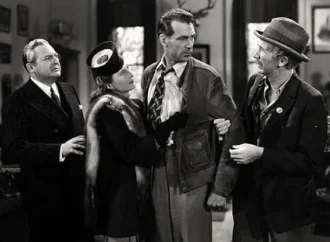Twitter likes to vilify the large cookie-cutter suburban home with a garage bigger than the house itself. And surely this is in some way a symbol of a decadent, mobile society with little sense of place or community. But the American garage gets too much flack from even those on the right.
The house on the left says, “Cars live here.” The one on the right is for people. https://t.co/bDCLq4Z124
— C. R. Wiley (@crwiley1962) February 1, 2025
The American garage is more than just a place to park your car or store the leaf blower. The picture of a father elbows-deep in the bowels of his car with its hood up, while his son eagerly holds the flashlight just right, is profoundly American. It’s so American I was sure that there was a Norman Rockwell painting to that effect, only to find that my brain had conjured this depiction.
Rockwell did, however, paint another famous picture of a garage. The auto workers are at rest in this painting, gathered around a soldier just returned home from the battlefield, listening to his tales of heroism and triumph and loss. “Homecoming Marine” is often noted for its depiction of the inner conflict of a warrior who is barely not a boy returning home entirely different from how he left, but the setting of the painting says just as much. The marine is speaking to those he fought for – generations of men engaged in a common pursuit, one that at the time was almost a rite of passage for the American male. The young marine’s life stories are more exciting than the auto mechanics’, yet the mundane work of fixing a car was the work that preceded his decision to enlist.
Marine Homecoming (1945) by Norman Rockwell pic.twitter.com/VQW9yiXDLN
— 🇺🇸 The American Culturist 🇺🇸 (@MericaCulture) June 6, 2025
The American garage, in its classic sense, is a vanishing, predominantly male space, where men can exercise agency over their belongings in a task specifically oriented toward their families’ comfort. I’m not talking about the Iron Man style wealthy bachelor with his garage full of barely usable vintage cars fitted out with impractical glamor. Rather, it’s the everyday dad replacing the brakes on the family car once again, just like his father taught him, showing his son how to do the same.
This is something we lose with the advent of EVs and gas-powered vehicles that are intentionally made impossible to fix. Newer cars throw “codes” that even the dealer mechanics themselves can’t work out, and consumers are sent home with an even newer car with a slightly higher monthly payment and a thousand trappings that they never needed in the first place. Besides the irony that the green movement’s automotives are more wasteful and short-lived than a ‘70’s gas-guzzler, the new crop of cars is destroying an American pastime more fundamental than baseball.
Older cars were made to last. In the proverbial garage scene, the father is doing more than just working on the car. He is working on a car that was made by engineers who actually wanted it to work for him and his family. The son in the garage holding the flashlight for dad is learning how to maintain his belongings, how to take pride and ownership over what he uses.
Nowadays, most people don’t even own their cars, nor do they want to. What would be the point of owning a car you’ll have to take to a specialized engineer to fix when some part of the flashy computer system disintegrates and you’re forced to pay an inflated price tag?
At that point, the American garage would become merely a holding place for the vehicles we don’t really own and can’t ever hope to maintain. For now, there’s still the glimmer of an older America in her garages, as possibly the last generation of young men learn to fix what they already own.
—
The republication of this article is made possible by The Fred & Rheta Skelton Center for Cultural Renewal.
Image Credit: Pexels
18 comments















18 Comments
Seraphina Haley
June 14, 2025, 2:55 pmLast night, I only worked for 3 hours and made $12,000 — I still can't believe it! I always thought this stuff was fake, but richjob2.com proved me wrong!
REPLYTheresaANoyola@Seraphina Haley
June 18, 2025, 9:14 amJOIN US Making cash is very easy an simple now days. 2025 is the year of making money online . I am here to tell you guys that its so easy to make more than $15k every month by working online. I have joined this job 3 months ago and on my first day of working without having any experience of online jobs I made $524. This is just amazing. Join this now by Follow instructions here………….. https://Www.JoinSalary.Com
REPLYFeatherjourney@TheresaANoyola
June 23, 2025, 11:01 amI am making a good salary from home $1400-$2400/week , which is amazing, under a year back I was jobless in a horrible economy. I thank God every day I was blessed with these instructions and now it’s my duty to pay it forward and share it with Everyone,
Here is what I do…… https://Www.Cash43.Com
REPLYTheresaANoyola@Seraphina Haley
June 18, 2025, 9:16 amJOIN US Making cash is very easy an simple now days. 2025 is the year of making money online . I am here to tell you guys that its so easy to make more than $15k every month by working online. I have joined this job 3 months ago and on my first day of working without having any experience of online jobs I made $524. This is just amazing. Join this now by Follow instructions here………….. https://Www.JoinSalary.Com
REPLYsaywsa@Seraphina Haley
October 9, 2025, 2:33 amAs you continue through the game, you will be able to acquire cool-looking snowboards with a variety of designs by paying the presents you gather throughout your runs. This will give you a feeling of progression and customisation. https://snowrider3d.com
REPLYStormi Brittany
June 14, 2025, 3:01 pmLast night, I only worked for 3 hours and made $12,000 — I still can't believe it! I always thought this stuff was fake, but richjob2.com proved me wrong!
REPLYBaylor Jessie
June 14, 2025, 3:02 pmLast night, I only worked for 3 hours and made $12,000 — I still can't believe it! I always thought this stuff was fake, but richjob2.com proved me wrong!
REPLYDevis1
June 15, 2025, 8:05 amI remembered how recently after a long day at work I just wanted to change the scenery and spend time away from home. I decided to try an escort service and settled on https://www.vibe-city.com/escorts-mo-saint-louis . The service pleasantly surprised me with its attentive approach and convenience. The meeting turned out to be kind and easy, without unnecessary tension – exactly what you need to reboot and have positive emotions.
REPLYRuby Eloise
June 17, 2025, 4:52 pmI am profiting (900$ to 1000$/hr )online from my workstation. A month ago I GOT chek of about 30k$, this online work is basic and direct, don’t need to go OFFICE, c160 Its home online activity. By then this work opportunity is fbegin your work….★★
Copy Here→→→→→ richjob2.com
REPLY